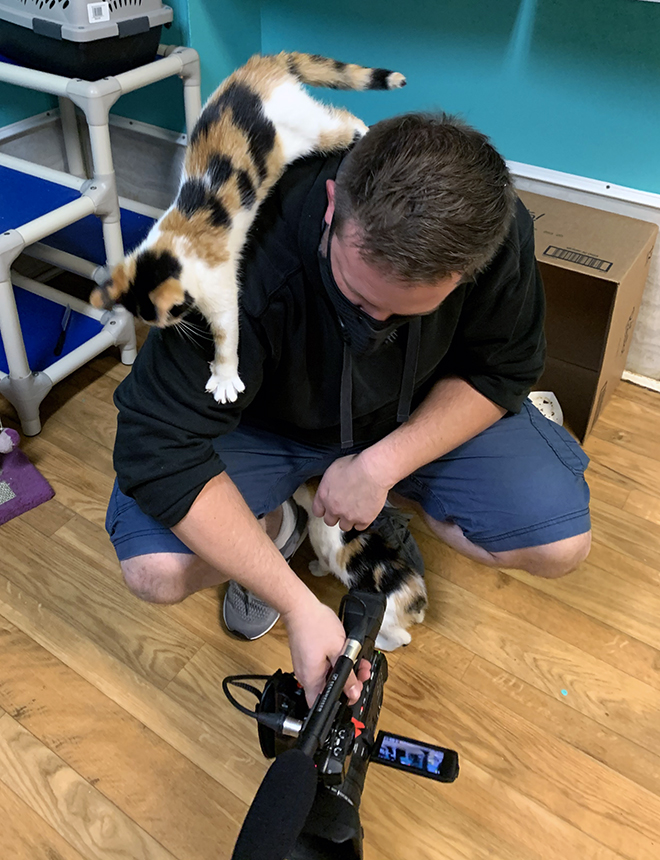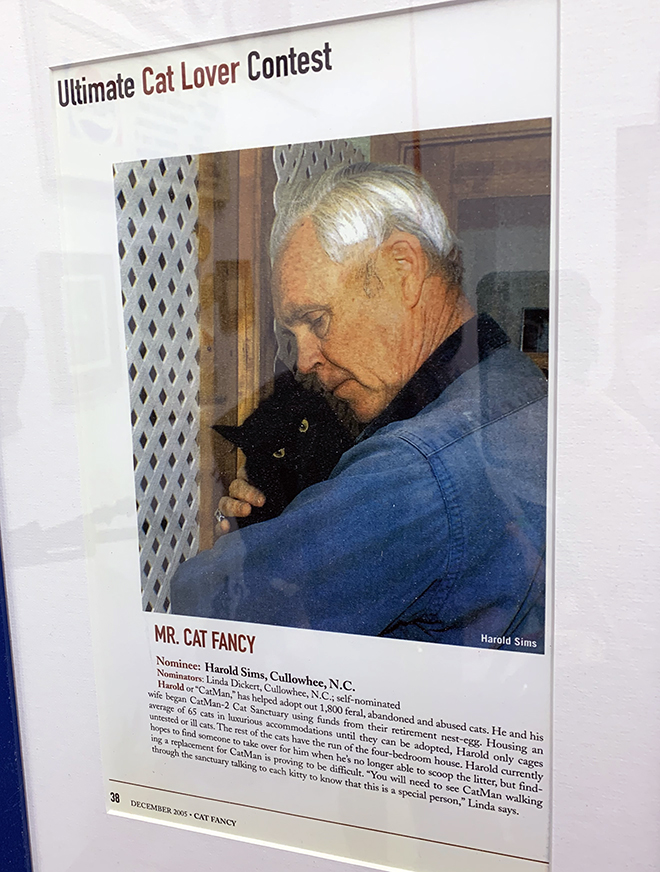

Help Dr. Harold Sims Keep His Legacy Alive
Dr. Harold Sims is one of the most inspiring people I have ever met with an incredibly unique story that comes with him. In the 1990s, he found that in his area of North Carolina, there weren’t any shelters that didn’t euthanize pets. Upon finding this out, he worked to open CatMan2, a private, no-kill, cage-free shelter in Cullowhee, North Carolina. CatMan2 not only saves the lives of many cats, rescuing those who have been in accidents and saving many kittens from shelters that kill, but they also offer low-cost spay and neuter services, help many cats find their forever homes, and provide resources for those with cats. They recently opened a wildlife rehabilitation section of their shelter, as well.
But this kitty-filled tale doesn’t stop there. Around 30 years ago, Dr. Harold Sims realized that there were no cat museums in America. It took him years to bring his dream to life, but in 2017, he opened the American Museum of the House Cat within an antique mall. His museum grew and thrived, allowing him to transition to a new building across the street. Proceeds from the museum go to help fund the CatMan2 Shelter. It’s also important to point out that his museum houses an exceptionally large and impressive array of cat items dating back hundreds of years. It’s a cat collector’s dream!
As someone who has experienced much in his life, Dr. Sims is concerned for the future of his legacy and is looking to seek funds for and legal advice for an endowment fund to keep his legacy alive for many years to come. He wants to leave this world with his legacy safe and thriving and for someone or an entity to take the title to his land to continue his work. Please help Dr. Sims spread the word to keep his legacy alive by reading his letter HERE and donating to his incredible cause HERE.
We sat down with Dr. Sims for Weird World Adventures and discussed all about CatMan2 and the American Museum of the House Cat. Please read on below to hear Dr. Sims’s story in his own words. I’m sure it will inspire you as much as it has inspired me.

VGM: Dr. Sims, what stimulated you to open a no-kill, no cages cat shelter in 1995?
Dr. Sims: After I retired from being a Professor of biology, I had a chance encounter at an animal shelter in Florida. The shelter dealt with both dogs and cats. The dogs were housed in runs that included covered spaces and a fenced run. The cats were sheltered in what were “Kitty Condos”. Each was a 400 square foot concrete area surrounded with 16 ft high, roofed-over chain-link fences. Each condo had a two-door entrance to allow human entry without a cat escaping, open space for cats to run and a house with many rooms to sleep in. Each condo could accommodate up to 15 to 20 cats based on their size and temperament. At the time my volunteering, it was something to do before my wife retired, and then we would move to our home in North Carolina, but my time there set me on a lifelong adventure with cats.
Soon after we moved and settled in North Carolina, I learned that the town we settled in was trying to build an animal shelter, and I volunteered to help. I invested a modest sum of money and donated items to be sold in a thrift shop. I even was given a low-level membership on the BOD. The cat problem there was serious as no one was rescuing cats there, and the county shelter at the county seat was a kill-shelter, and it euthanized more animals than it found homes for. To help save cats’ lives, I started transporting cats to the shelter I’d volunteered at in Florida and I waited, in hopes that the town where I had settled would someday open their shelter. I tried to encourage the town to shelter their cats as they were in Florida but had no luck in doing so.
When the shelter opened it had no condo-like accommodations, the cats lived in small cages and it opened as a kill-shelter. Kill-shelters seem to be more interested in animal control than adoptions, and they don’t have the time to do animal control (Getting strays and abandoned animals off the streets). On the whole, they euthanize more animals than they find homes for.
In 1996, I gave up trying to change things at both the town and county shelter near Sylva, and I opened a small shelter of my own in a refurbished tool shed. It was both a no-kill and a no-cage cat shelter- A first for the county as no-kill and a first for the local area as a no-cage shelter. This became known as The Catman2 Cat Shelter. It operated and expanded it until 2001 when I moved to the county seat and built the 4000 sq ft facility near Cullowhee.

How were you able to do this?
I’d inherited a sum of money from my great aunt and used most of it buy the land, move to Cullowhee and build the shelter. I didn’t get any help doing this. I couldn’t raise a cent. I paid for it with the money I inherited and built everything myself.
What was your inspiration for doing it?
I saw the need for a no-kill shelter. I had the money. The cats needed it. So, I built it because I saw the need.
How did you come up with the idea to open a cat museum?
My wife and I were riding through a town one day, and we saw a sign advertising The Museum of the Mule. My wife asked if I knew any museums of the house cat. I learned there were many overseas but none in America. This happened in the 1990’s, so I guess my idea for a cat museum predates the cat shelter.
Who owns the items in the museum?
I own all the items in the museum. I found them during our travels. I bought them on the internet and at auctions. I’ve collected cat memorabilia long before the 1990s and up to the day I opened the museum. Before then, my home and the cat shelter looked like a museum. I didn’t get any help finding items for the museum. Everybody said I was crazy. I knew nothing about operating a museum. People said I wouldn’t be able to do it, but I did.
How did you pay for the museum?
I had started buying cat related items long before the idea of opening a museum. I like cats and art, so I bought art and small items that I could afford, so my investment was made over a long period of time. After the idea of opening the museum, I bought a lot more. I had a plan in my mind, and I bought things I wanted to have in a cat museum.

Did anyone donate any money or items for the museum?
No, not one cent until it was opened. Then, I was given a few items. I made a video and put it on YouTube. It asked for help. It found none.
How were you able to afford to do this?
I sold my first home in North Carolina for much more than I paid for it. I banked the money. It earned interest. My wife and I could have had a life of travel, but I had a cat shelter to run. So why not open the cat museum I’d dreamed about?
How does the museum operate?
The museum and its contents belong to me. I do not accept items for the museum unless they are given to me. The museum operates as a non-profit 501 C3 (As does the cat shelter). Income to operate the museum comes from ticket sales and monetary donations. This income pays operating costs and salaries. I do not take a salary from either the cat shelter or the cat museum.
What are your hopes and plans for the future?

I would like to have both of them operate with a foundation. I think the cat shelter has a good start towards that. It has run and grown larger for the past ten years without much help from me. The museum is in jeopardy. It needs to find the funds to form a foundation. It needs help from major charities, the corporations that profit from the sale of cat-related products, and the people, who I built it for, the people who love cats. Without a foundation with people of worth to operate it, the future of the museum seems bleak. I see it as a treasure that needs to be preserved for all cat lovers. It would be a shame and a great loss for all if the museum were to die with me. I am age 85. How much time is left?
When I retired, I never thought I would end up being a philanthropist, but I could because I lived during some of the best of times in America, at a time when a person like me could make money by selling his home for more than he paid for it. He could buy CD’s that earned 10 percent interest, be paid a good retirement for as long as he lives and be lucky enough to have inherited some money. I had a good life, and I am glad that I was able to give back what I could for the benefit of man and cats.
It was Andrew Carnegie who said, “No man becomes rich without himself enriching others.” And, “The man who dies rich dies in disgrace.”
And, I think somebody else said, “We should not be judged by how rich we are when we die but by how much we have given away before we die.” …Maybe I said it.
I hope you are as inspired by Dr. Sims’s story as I am. If you are interested, there are a few ways you can help:
1- Please share this and help Dr. Sims’s story be seen by the right people!
2- If you can donate to the American Museum of the House Cat, CatMan2, and Dr. Sims’s legacy, it would mean the world to him. You can do that here:
https://www.paypal.com/us/fundraiser/charity/3587764
http://www.catman2.org/donate.html
3- At the time of his death, he would like to bequeath his ownership to an updated 501 C3 corporation that will hold the title to the museum and the land. Anyone that can help provide legal advice (specifically in North Carolina) would be much appreciated.
4- If you’re in his area of North Carolina, utilize his low-cost spay and neuter services at CatMan2.
5- If you know anyone interested in working first-hand to help keep his legacy alive in any way, please e-mail me at maloriemackey (at) gmail (dot) com or contact the good people at CatMan2 and the American Museum of the House Cat.
YOU MIGHT ALSO LIKE:
King Neptune’s 3D Mini Golf Brings a New Take on a Favorite Hobby
























